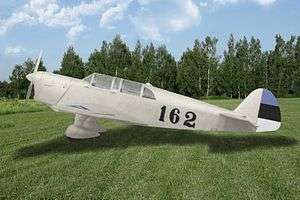PTO-4
| PTO-4 | |
|---|---|
 | |
| РТО-4А | |
| Role | Trainer |
| Manufacturer | Aviotöökoda, Tallinn |
| Designer | Voldemar Post, Richard Tooma and Otto Org |
| Introduction | 1938 |
| Retired | 1944 |
| Primary user | Estonian Air Force Luftwaffe |
| Produced | 1938 |
| Number built | 8 |
|
| |
The PTO-4 was an Estonian-designed military training aircraft of World War II.
In 1938, the Estonian aviation engineers Voldemar Post, Rein Tooma and Otto Org, previously responsible for the PON-1 trainer, designed and built the PTO-4 training aircraft.[1] It was a two-seat low-winged monoplane powered by a De Havilland Gypsy of 120 hp, with a fixed undercarriage that could be fitted with wheels or skis. The aircraft could fly at a maximum speed of 245 km per hour and had a ceiling of 5,000 meters. On 12 October 1938, the PTO-4 was taken into service of the Air Force.
The Estonian Air Force received two PTO-4s (serial numbers 161 and 162), one with an open cockpit and the other an enclosed cockpit.[1] Six examples were in civil use, of which five were used by the Eesti Aeroklubi (EAK), a flying club controlled by the Estonian Military.[1]
Four examples surviving from the Soviet occupation of Estonia (1940-41) were operated by the German Luftwaffe, being operated by a unit manned by Estonian volunteers (initially called Sonderstaffel Buschmann and later 1./SAGr.127) based at Reval-Ülemiste airfield. They were operated as training and liaison aircraft as well for coastal patrol over the shores of the Baltic.[2]
Operators
See also
| Wikimedia Commons has media related to PTO-4. |
- Related development
- PON-1
- PON-2
- PN-3
- Related lists
References
- Gerdessen, F. "Estonian Air Power 1918 - 1945". Air Enthusiast, Eighteen, April-July 1982. Bromley, UK:Pilot Press. pp.61–76.
External links
- Estonian Postage Stamp
- PTO-4 (Polish) - Translation